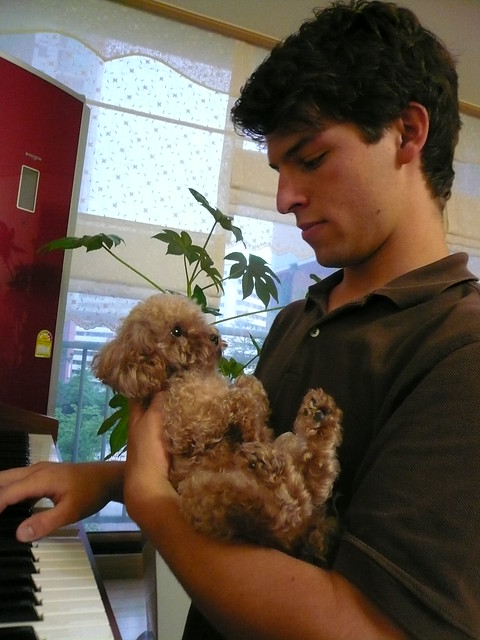A recent post in a music therapy group inspired this one. Thanks Amy Kalas for throwing the question out there! And a special shout out to all the MT's that contributed their amazing ideas. Every person is different, so if you have an idea that worked for you, please let us know!
TIPS TO GET YOU STARTED:

- Set a time to practice. While mom's prepping dinner, before your evening snack, or as soon as you get home. Make it part of your daily routine, and try to keep it consistent. Instruments as Home Decor
- Think about where it fits best in the days schedule, and what time of day is most productive. Practice time should be convenient.
- Put your instrument in a convenient and comfortable location. My double bass and piano both make beautiful living room decorations.
- Plan ahead for vacation time. Your teacher can help give suggestions on how you can practice in the car, on the plane, or while in line at the DMV...those times do not need to be a waste. You'll be surprised by what you accomplish without the instrument in front of you.
- Parents of young children should be involved in the process, and may need to help their child take ownership over their practice routine, and help their child establish good habits. Use reinforcements in lessons and at home.
- Keep a Practice Journal. Make it fun and easy to use. (check out these examples). Journaling is a great way to track progress and to remember what you need to practice.
- Practice a little EVERY day, no matter what. This is far more beneficial that one or two long practice sessions a week. Your brain and your muscles need the exercise to stay strong. 2 minutes of plunking around is better than 0 minutes. And sometimes you'll surprise yourself and hang in a little longer than expected. Often the hardest part is getting started.

- So much to do, so little time? Split your daily practice into smaller chunks (exercises and technical work in the morning &symphonies in the evening).

- Young children and adults benefit from shorter & more focused chunks of practice time. 10-minutes of dedicated and focused practice is better than doing a quick run through of the stuff you like. Quality is better than quantity.
Double Bass on the Run!
- Warm Up & Cool Down. Begin & end your practice session on the easy/fun stuff. This makes it success oriented and much more enjoyable. Scales and arpeggios, Dozen-a-Day, Hanon, whatever it is that gets the chops ready, do it first. If you've mastered a piece, play it through at the end of your practice and show off your success. If you're still working on mastery of your current material, review old stuff that you enjoy playing.
perfectly positively wonderful way to end the day!
- Teachers should assign easy material with the crazy stuff. Don't stress your students out, and keep their confidence up.
- Improvising & Sight-Reading can also be great rewards to end a hard days work. No need to worry about perfection, just enjoy and make some music, and finish on a high note.
- Enjoy the Music. Practicing music does not have to be work. If you're having a rough day, or you are stressed out, take it out on the instrument and focus on something positive. Music is meant for this sort of thing. Instead of taking a day off of practice, take a day to enjoy your well honed skills, let your mood guide your practice sometimes. And maybe you're having a great day, but you have too much energy to focus on practice? Use the iso principle...Play something loud and crazy, and re-focus that energy before bringing it down.
- Quality Tools Make the Difference. A dull knife makes cutting slow, painful, and treacherous. A dull knife drains your energy and takes away the pride from your finished product. A dull knife is no good. The same holds true to a dull instrument. Quality instruments want to be played and set the stage for success and pride.
- Think about the Ultimate Goal. Write down long term and short term goals, and refer to them regularly.
- Teachers & parents can use these goals as motivators to practice.
Teacher: "If you play this every day, you'll be like Bieber in no time".
Parent: "Let's see Bieber play".
Kid: "It's Bieber time"
TIPS TO BE A PRO:
- Practicing should be FUN AND GOAL ORIENTED. The student and teacher should know the specific goal and purpose of each exercise. Music is naturally enjoyable, but the hard stuff sometimes takes that feeling away...don't let it! Have fun and hide the hard stuff inside motivating material.
- Motivating Material: A favorite tune; A funny sound (beatboxing flute); Fun arrangements (The Piano Guys); Upbeat tempos; Variety is the spice of life (play it fast/slow, loud/soft, short/long, high/low, forwards/backwards)
- Play games:
- Need to practice rhythms? Bounce a ball to the beat while counting the rhythm, then try to bounce the ball fast/slow to the rhythm.
- Need to practice phrasing? Walk, skip, dance, and wave a scarf to the music. Then go show off your new dancing skills at the next school dance.
- Finger Exercises - Build up your dexterity and finger independence, then make a video of your finger dance...Finger Fitness Exercise
- Practice the hard bits – not just the bits you like...but Don’t practice mistakes or you will become very good at playing them. Stop and Start over, and over, and over...until you get it right. It's fun to break a good habit, but bad habits are hard to break.
- Run-throughs should only be done after the kinks are worked out.
- Break it up. Learn each piece a phrase at a time. Practice each phrase SLOWLY until you have it and then move on.
- If you're a pianist, first practice the Right hand, then the Left hand, and then together. If you play a wind or brass instrument, practice the fingerings, then the articulations & rhythms separately. Put it all together after you break it up.
- Start at the end. Starting at the beginning of the piece and playing through to the end each time you practice is not an effective use of your time! You are merely practicing mistakes!
- Record yourself and listen carefully to it. Listen to the pros play your pieces right, while following along with the sheet music, and then try to emulate them.
USE REINFORCERS (Tangible & Intangible)
Change it up every now and then to keep it exciting..."HEY! Guess what? You've graduated from stickers!!!" All of these reinforcers may be used in lessons and at home.
- Stickers - put them on the pages that are mastered, or on the instrument case as a proud collection to show off, or use them in a token economy (eg: collect 10 stickers, earn a prize). Sometimes I send mom home with a sheet of stickers to reward practice. If you're too cheap for stickers, try ink stamps!
- One of my students just loves it when I use my big fat colorful markers and write A+++++. And he will do anything for me to add extra +++. Find what motivates them, and go with it!
- Token Economy - Collect a specified number of checks/stars/notes/etc. and earn a larger prize.
- Music Sharing, Music Listening...to your favorite tunes, or check out the teachers music collection, and bring in your favorite CD to share.
- Verbal Reinforcers & Encouragement: "Amazing", "I love how you...", "Oh that's beautiful", "WOW! your hard work paid off", "Keep it Up", "Keep going, almost there", "YES!" Regular verbal praise is so important, but you need to make sure it reflects what the student is doing, and is genuine...change it up and keep it positive.

- Free Time - explore a different instrument for 5-minutes, play a music related computer game or video game, explore a box of rhythm instruments or some cool new music technology
- Play along with the teacher or perform with mom and dad (I bet mom and dad can play a really great kazoo harmony to accompany you).
- Beginners can quickly learn a repetitive bass line to a popular tune (there is beauty in 3 chord songs!) Or even just a rhythm to play along with on a drum. Reward your students with a successful experience that is adapted to their ability.
- Put on an evening talent show for your family. If you dare, let the judging panel vote for the best of America's Got Talent!
- Play in a recital, for a talent show, at church, for a wedding, at a remembrance ceremony. Be part of a group and have a reason to perfect your work.
- Make a Recording. Work towards a larger project and involve the student in the process. Create a Music CD or Video that can be shared with family and friends as holiday gifts. The process of creating the project can be done throughout several lessons, letting the student do anything and everything from design, music editing, visuals, marketing, etc.
- Make original compositions. I use Sibelius to transcribe my students own compositions. They love seeing a polished product that they created.
And with that said...Music Therapist Heather Lantry put it right...
"Don't Practice!
Practicing Stinks!
Make music every day,
because making music is FUN and
BEAUTIFUL and WONDERFUL and
POWERFUL and will FEED YOUR SOUL."








